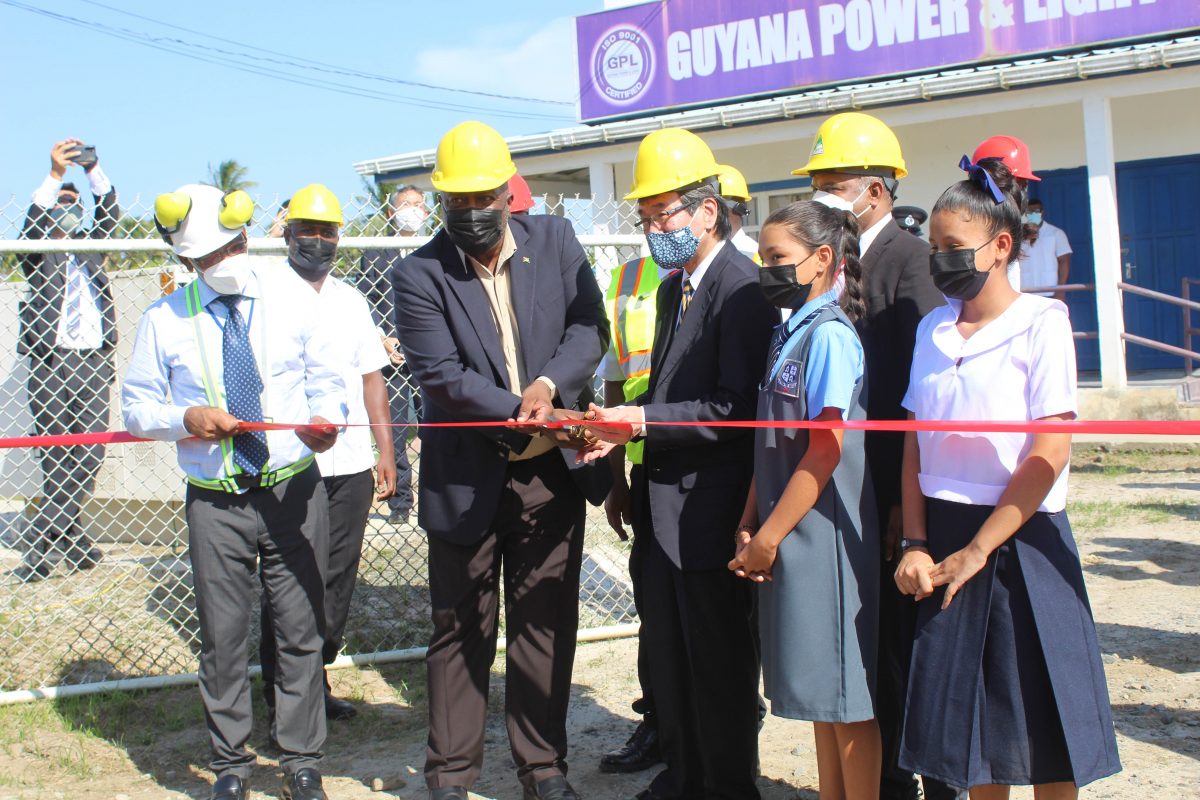Prime Minister Mark Phillips yesterday assured that there would be a stable and efficient power supply with the completion of major upgrades costing $1.4 billion to the Canefield Substation, in East Canje, Berbice.
Phillips, who delivered the feature address at the commissioning of the upgraded substation yesterday, acknowledged the challenges faced in regards to power generation but pointed out that the upgrades were groundbreaking as he noted that never before in the history of the Guyana Power and Light (GPL) has there been the installation of a “reactive compensator in the transmission network.”
He said, “This upgrade will provide reliable, stable, and efficient power in our system and is a first in many steps towards my government’s commitment to enhancing the capacity of GPL with regards to sustainable power generation to our citizens.”
He explained that the upgrades were made possible through a 2018 grant agreement between Guyana and Japan for the introduction of a renewable energy-efficient system.
According to Phillips, since the PPP/C has taken office intense efforts have been made to work closely with GPL to address the various challenges faced by the company in regards to its capacity to supply power to its 200,000+ customer base.
Due to inadequate maintenance under the previous administration, he said, GPL has struggled to overcome issues which have led to continued outages in various areas, especially in Region Six. He pointed out that almost every day he receives a phone call from persons in the region complaining about low voltage and/or blackouts.
“However, GPL has since been involv-ed in remedying these issues through continued extensive repairs to its transmission and distribution system and other critical areas that affect its overall functioning and efficiency.”
He noted that an unreliable power supply could make businesses vulnerable and could severely affect a country’s economic development.
“Therefore the administration must prioritise the maintenance and capacity building of institutions such as GPL to contribute to sustainable power supplies due to the long term national benefits.”
Phillips further noted that as the world moves to switching to a fully sustainable global energy landscape which can ultimately reduce energy use and cut costs, Guyana is not being left behind as the government is working towards this goal. “That goal is to use more renewable energy”, he stressed.
Touching on the PPP/C’s pledge in its manifesto to provide affordable, stable, and reliable energy through the energy mix, which includes utilizing fossil fuels, natural gas, hydropower, solar power, and wind power, Phillips said, “Our aim is to provide an additional 400 megawatts of newly installed capacity for residential and commercial industrial users”.
Pipeline
Among the initiatives in the pipeline towards this end, he said, are the Amaila Falls Hydro project, investments in solar and wind systems for off-grid areas and developing microgrids for large hinterland villages, expansion of the hinterland electrification programme and urgent action to improve and upgrade the national grid in regards to both transmission and distribution.
“At this location in Canefield, this upgrade has been coupled with other maintenance work to build its capacity… As we look towards the immediate future, this project of reactive compensation is just the first of many planned for other substations at Good Hope, Sophia, and Edinburgh”, he added.
“My government is steadfast in continuing its support to GPL as it seeks to further develop and improve the reliability and the quality of service to all our customers throughout Guyana”, Phillips further said as he thanked the Japanese government for its generosity. “We hope to continue to develop these and others areas of mutual interest as we seek to strengthen our friendly bilateral relationships,” he added.
Meanwhile, Minister within the Ministry of Public Works Deodat Indar, who also attended the commissioning yesterday, said that there were a number of “hiccups” that caused the project to “start and stop.” However, under the new management they were able to get it done. “What it means with this new power substation is that they will have more quality power coming to them, they will have a better intake of power, distribution of power.”
Indar pointed out that a lot of outages over the last few months were as a result of the testing of the upgrades, “so there are pains in getting to completion…” as he stressed that with rehabilitation and implementation of new systems comes certain challenges.
He also reminded that some blackouts might still occur when maintenance and other works are carried out. “It’s a continuous process”, he said.
Also present yesterday was Ambassador of Japan Tatsuo Hirayama, who spoke of the importance of maintaining a good relationship between the two countries. The Ambassador also pointed out that due to COVID-19 there were some delays and challenges. (Bebi Oosman)






